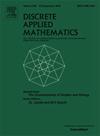用于可追溯性和哈密性的断开图的禁止对
IF 1
3区 数学
Q3 MATHEMATICS, APPLIED
引用次数: 0
摘要
在本文中,我们首先描述了有跨迹的可溯源图和可溯源的哈密顿图的所有禁止对{R,S}。如果我们施加一个假设必要条件,即图是可溯源的,则hamiltonicity 的禁止对没有任何变化;但是,如果我们施加一个假设必要条件,即图是有spanning trail 的,则可溯源性的禁止对有一些不同:在两对禁止子图{K1,3,Z2∪K1},{K1,4,Z1}(其中 Zi 是将 K3 的一个顶点与 Pi+1 的一个末端顶点识别后得到的图)上不同。作为副产品,我们证明,如果 G 是一个连通的 {K1,4,Z1} 无图,那么由轨迹 T 引导的每个子图 G[T] 都是可跟踪的,而由封闭轨迹 T 引导的每个子图 G[T] 要么是哈密顿图,要么是 K2∨3K1 图。本文章由计算机程序翻译,如有差异,请以英文原文为准。
Forbidden Pairs of disconnected graphs for traceability and hamiltonicity
In this paper, we firstly characterize all forbidden pairs for graphs with a spanning trail that are traceable and traceable graphs that are hamiltonian. There is no change of forbidden pairs for hamiltonicity if we impose a necessary condition of assumption that the graph is traceable; however, there is some difference of forbidden pairs for traceability if we impose a necessary condition that the graph has a spanning trail: different on two pairs of forbidden subgraphs (where is the graph obtained by identifying a vertex of a with an end-vertex of a ).
As a byproduct, we prove that if is a connected -free graph, then every subgraph induced by a trail is traceable and every subgraph induced by a closed trail is either hamiltonian or .
求助全文
通过发布文献求助,成功后即可免费获取论文全文。
去求助
来源期刊

Discrete Applied Mathematics
数学-应用数学
CiteScore
2.30
自引率
9.10%
发文量
422
审稿时长
4.5 months
期刊介绍:
The aim of Discrete Applied Mathematics is to bring together research papers in different areas of algorithmic and applicable discrete mathematics as well as applications of combinatorial mathematics to informatics and various areas of science and technology. Contributions presented to the journal can be research papers, short notes, surveys, and possibly research problems. The "Communications" section will be devoted to the fastest possible publication of recent research results that are checked and recommended for publication by a member of the Editorial Board. The journal will also publish a limited number of book announcements as well as proceedings of conferences. These proceedings will be fully refereed and adhere to the normal standards of the journal.
Potential authors are advised to view the journal and the open calls-for-papers of special issues before submitting their manuscripts. Only high-quality, original work that is within the scope of the journal or the targeted special issue will be considered.
 求助内容:
求助内容: 应助结果提醒方式:
应助结果提醒方式:


